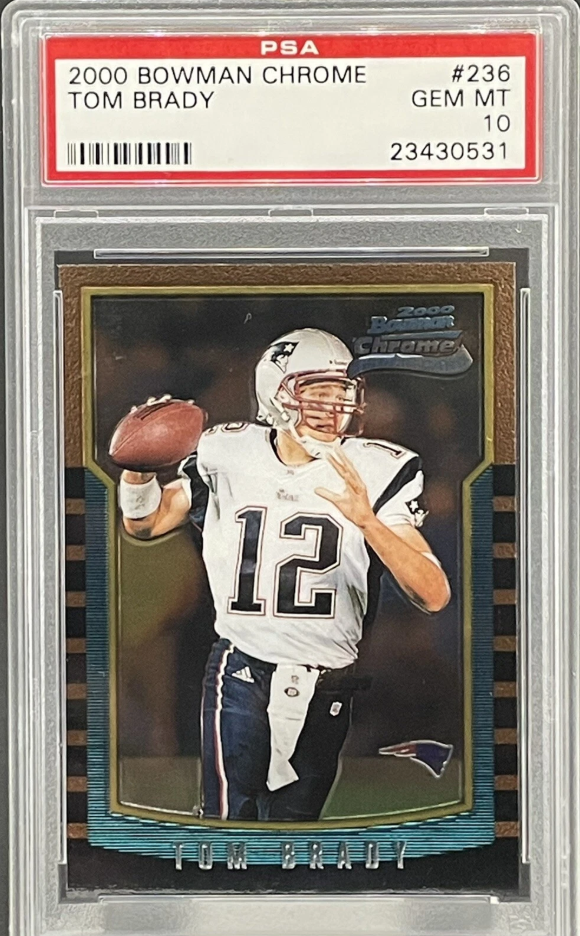In the glittering galaxy of sports trading cards, where some stars fade after a brief glow, Tom Brady’s 2000 Bowman Chrome rookie card, adorned with the number 236, remains a steadfast beacon. A card that never relinquishes its gleaming appeal, it has traversed two distinct phases in the hobby realm: initially a hidden gem nestled in the boxes of the early 2000s, and subsequently morphing into an exemplar for assessing modern football card value. A dazzling chromium counterpart to the paper Bowman, it boasts a minimalist design with a sharp image—everything a rookie card should embody.
Over the years, its price trajectory has maintained a predictable rhythm. This summer alone, PSA 10 versions of the card have been drawing close to the ten-thousand-dollar mark, occasionally surging higher when competitive bidders engage in spirited duels. Card Ladder’s database recently recorded a gem-quality sale at fourteen thousand, with current value hovering slightly above ten thousand, consistent with live eBay results. For aficionados of modern football blue-chip cards, discussions inevitably settle at the ten to fourteen range.
PSA’s auction records add rich context to these headline figures. A June eBay auction saw a PSA 10 fetching a bit over eight thousand dollars. Thousands of sales across various grades underscore the card’s liquidity, while population data provide further insights. With over twelve hundred PSA 10s documented, there is sufficient supply to keep comparative analyses fresh, while simultaneously maintaining a scarcity that accentuates the significance of eye appeal and strategic timing.
The allure partly rests in its design—a masterpiece of simplicity and elegance. While devoid of ostentation or gimmicks, it captures Brady in the nascent stages of his New England legacy, with the chromium brilliance doing justice to the pivotal image. Unlike some of the more garish designs from the turn of the millennium, this card’s straightforward photograph keeps it timeless, a rookie card worthy of being framed in any collector’s display.
Collectors often find themselves drawing comparisons across the spectrum of cards. The paper Bowman is a close cousin, and there exist other alternatives from his rookie year, embellished with autographs or serialized for exclusivity. Yet, the discourse inevitably circles back to the Chrome variant—its blend of recognition, rarity, and affordability render it an enduring favorite. Even casual enthusiasts recognize it instantaneously. Dealers, armed with recent sales data, can price it confidently. And when ranking Brady’s rookie cards, the Bowman Chrome invariably sits in the top echelon.
The narrative of this card is also written in its condition challenges. Centering and surface imperfections are perennial hurdles in the realm of chromium cards. Here, too, they present a persistent issue. The difference in value between a PSA 9 and a PSA 10 is substantial, both financially and psychologically. Nines close in tighter ranges, while tens tend to headline sales. For raw card seekers, scrutinizing for edge chipping, roller lines, and off-center images is crucial before aiming for a PSA grading.
Market watchers who thrive on sales comps have a straightforward playbook: track evening eBay auctions for tens to obtain a real-time sense of market sentiment. Most cards will settle around the ten-thousand-dollar mark, though some reach twelve thousand or more when competitive fervor peaks among bidders. Using Card Ladder or a similar tool to monitor deviations from the norm, such as the $14,000 sale, is advisable. The card’s high volume of transactions eliminates much of the uncertainty in pricing.
What solidifies this card’s market resilience is its universal appeal across collectors’ demographics. Set builders appreciate its anchoring role in early Bowman Chrome football series. Player collectors view it as the quintessential chrome testament to Brady’s rookie year. Investors favor the card for its known population and reliable liquidity. Even casual buyers looking for a single standout Brady piece eventually gravitate towards it as it encapsulates the legend’s journey without the need for elaborate storytelling.
The thrill of discovery in the wild persists as well. In elite circles, the high-stakes Galaxy Rip Packs have been known to contain the 2000 Bowman Chrome Brady rookie, infusing the chase with genuine excitement capable of transforming an ordinary evening into a memorable one. While the inventory shuffles and probabilities cannot be guaranteed, the possibility injects a shot of adrenaline into the hearts of collectors.
For those committed to acquiring a slabbed card, the decision hinges on whether to opt for the charisma and prestige of a PSA 10 or the still-commendable value of a PSA 9. Both categories boast robust market comps and sell swiftly when priced near recent benchmarks. PSA’s transaction logs offer a logical checkpoint before initiating a bid.
Ultimately, this card is more than just a piece of cardboard with a famous face. It is the embodiment of a career that requires no embellishments. As a PSA 10 trades at ten thousand and select copies climb to fourteen, the reason is clear—it isn’t mere hype but rather the faith of a market grounded in historical excellence. Whether drawn in by a Galaxy Rip Pack, pursuing a radiant raw card, or securing a slab for safekeeping, one is not merely purchasing a relic of Tom Brady’s rookie year; they are acquiring a perpetual piece of sporting history that, even a quarter-century later, remains vividly relevant.





